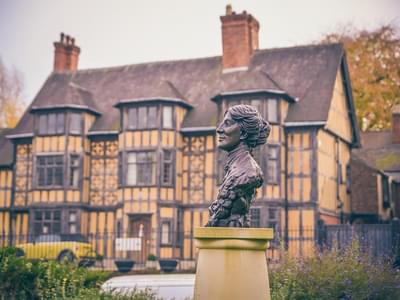- Features
- Famous historic faces of Shrewsbury
Famous historic faces of Shrewsbury

Charles Darwin was born in Shrewsbury in 1809 and is certainly the town's most famous son. He was educated at Shrewsbury School, in the building that now houses Shrewsbury Library, where his statue sits proudly. Darwin's childhood was shaped by explorations about the River Severn and studying creatures in the Quarry Park. The town celebrates Darwin in February with the Darwin Festival, including events held in the gardens of Mount House, his childhood home. Find out more about Darwin's Shrewsbury.
Admiral John Benbow was born in Coton Hill, Shrewsbury, and became famous whilst fighting the French during the war of Spanish succession where he became a British naval hero.
Blue Peter gardener Percy Thrower made his mark on Shrewsbury with the re-design of the floral masterpiece, the Dingle, in the town's 29 acre Quarry Park. As Park Superintendent, Thrower was responsible for the Quarry for 28 years.
Award-winning author Mary Webb was born in Leighton, a village south of Shrewsbury in 1881 and later moved to Meole Brace. She grew up exploring the countryside and was inspired by the nature that surrounded her. In 1907, Mary wrote a poem about the Shrewsbury rail accident that resulted in the death of 18 people, which her brother published without her knowledge in the Shrewsbury Chronicle. Mary Webb went on to write a series of novels, most famously Precious Bane in 1924. However, she was not recognised until after her death, when then Prime Minister, Stanley Baldwin praised her work as a writer at a literary dinner.
Lord Rowland Hill became one of Shrewsbury's most distinguished soldiers at the battle of Waterloo where he was second in command to the Duke of Wellington. Look out for his statue on top of the column on Abbey Foregate.
Born in Kent in 1554, Sir Philp Sydney was educated at Shrewsbury School, then at the age of 18 was elected to Parliament as the MP for Shrewsbury. An accomplished poet, courtier, scholar, and solider, Sidney was one of the most prominent figures of the Elizabethan age. Sidney died at the age of 31 from gangrene, having been shot in the thigh fighting for the Protestant cause against the Spanish. As he lay dying, Sidney composed a song to be sung on his deathbed, and, according to the story, while lying wounded he gave his water to another wounded soldier, saying, "Thy necessity is yet greater than mine". His death inspired evolutionary biologist John Maynard Smith to formulate the signalling theory known as the Sir Philip Sidney Game. A noble and gallant character, Sidney's finest literary achievement was a sequence of 108 love sonnets, due to which many consider him the greatest Elizabethan sonneteer after Shakespeare.
The famous First World War poet Wilfred Owen is one of Shropshire's most well-known literary figures. Owen lived in Monkmoor and was educated at Shrewsbury Technical College. He was awarded the Military Cross in recognition of his courage and leadership. Today, you can visit his memorial in the grounds of Shrewsbury Abbey.
Born in nearby Market Drayton, Major General Robert Clive was MP for Shrewsbury from 1761 until his death in 1774, he was also elected Mayor of Shrewsbury 1762-63. Clive started his career as a British military officer and East India Company official, he was one of the key early figures setting in motion what would later become British India. Some of his actions resulted in the plundering of Indian treasures, and policies introduced on behalf of the EIC led to famines which proved disastrous to the local Indian farming population. Erected in 1860, a bronze statue of Clive of India stands in Shrewsbury’s town square.
